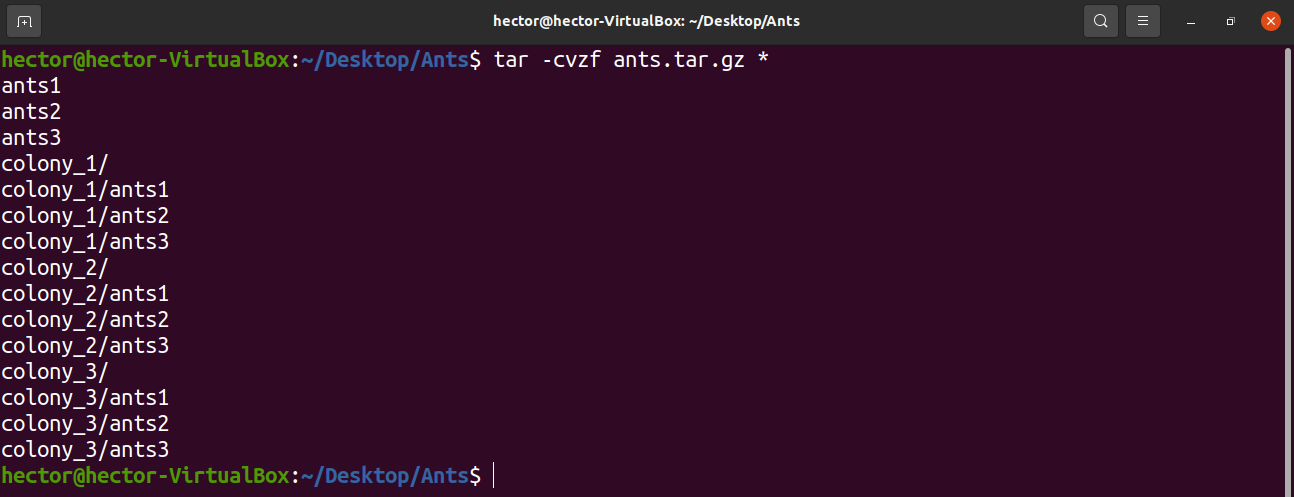

You can access this documentation by entering: GNU tar comes with additional documentation, including a tutorial, accessible through the GNU Info interface.
#Untar to directory manual#
For details, consult the tar manual page on the command line, enter: The tar command has many options available.
#Untar to directory archive#
For example, some versions of tar (not GNU tar) require that the -f option be immediately followed by a space and the name of the tar archive file. When using the tar command, the order of the options sometimes matters. To extract the contents of a tar archive file compressed with compress (for example, my_), use the following command: If you are not using GNU tar and need to extract the contents of a tar archive file compressed with gzip (for example, my_), use the following command: To extract the contents of a tar archive file compressed with gzip (for example, my_), use the following command: To extract the contents of a tar archive file created by tar (for example, my_files.tar), use the following command: If gzip isn't available on your system, you can use the compress utility to create a compressed archive (for example, my_) for example (replace file1 and file2 with the names of the files you want to combine): If your system does not use GNU tar, but nonetheless has gzip, you can create a compressed tar archive file (for example my_ with the following command (replace file1 and file2 with the names of the files you want to combine): tar.gz are equivalent both signify a tar archive file compressed with gzip.
#Untar to directory software#
Many Linux distributions use GNU tar, a version of tar produced by the Free Software Foundation.

The -v option tells tar to be verbose (report all files as they are added).If you don't use the -f option, tar will assume you want to create a tape archive instead of combining a number of files.You can use any name in place of my_files.tar, but you should keep the.If you find this guide helpful or have more information or additional ideas, you can give me a feedback by posting a comment. That is it with extracting tar files to a specific directory and also extracting specific files from a tar file. Img 05: Extract Specific Files From Tar Archive Summary # tar -xvf etc.tar etc/issue etc/nf etc/mysql/ -C /backup/tar_extracts/ In the next example, I will extract specific files out of a tar file to a specific directory as follows: # mkdir /backup/tar_extracts The tar utility also allows you to define the files that you want to only extract from a. Img 04: Extract tar.bz2 Files to Different Directory Example 4: Extract Only Specific or Selected Files from Tar Archive # tar -jvxf documents.tbz2 -C /tmp/tar.bz2/ Now we will be unpacking the documents.tbz2 files to /tmp/tar.bz2/ directory. tbz2 Files to Different DirectoryĪgain repeating that you must create a separate directory before unpacking files: # mkdir -p /tmp/tar.bz2 tgz Files to Different Directory Example 3: Extract tar.bz2. Files can be extracted using the -C flag with the specified folder path. Now we will extract the contents of documents.tgz file to separate /tmp/tgz/ directory. Tar utility also comes with a feature to extract tar files to a specific directory.


tgz Files to Different Directoryįirst make sure that you create the specific directory that you want to extract into by using: # mkdir -p /tmp/tgz Img 02: Extract Tar Files to Specific Directory Example 2: Extract. # tar -xvf articles.tar -directory /tmp/my_articles/ Let me also use the -directory option instead of -c for the example above. In the above example I used the -v option to monitor the progress of the tar extraction. Img 01: Extract Tar Files to Different Directory To extract the files in articles.tar to /tmp/my_article, I will run the command bellow: # tar -xvf articles.tar -C /tmp/my_article/ You can include the -p option to the above command so that the command does not complain. Let me start by creating the /tmp/my_article directory using the command below: # mkdir /tmp/my_article Always make sure that the directory into which you want to extract tar file exists. In the first example, I will extract the files in articles.tar to a directory /tmp/my_article. Example 1: Extracting tar Files to a Specific Directory


 0 kommentar(er)
0 kommentar(er)
